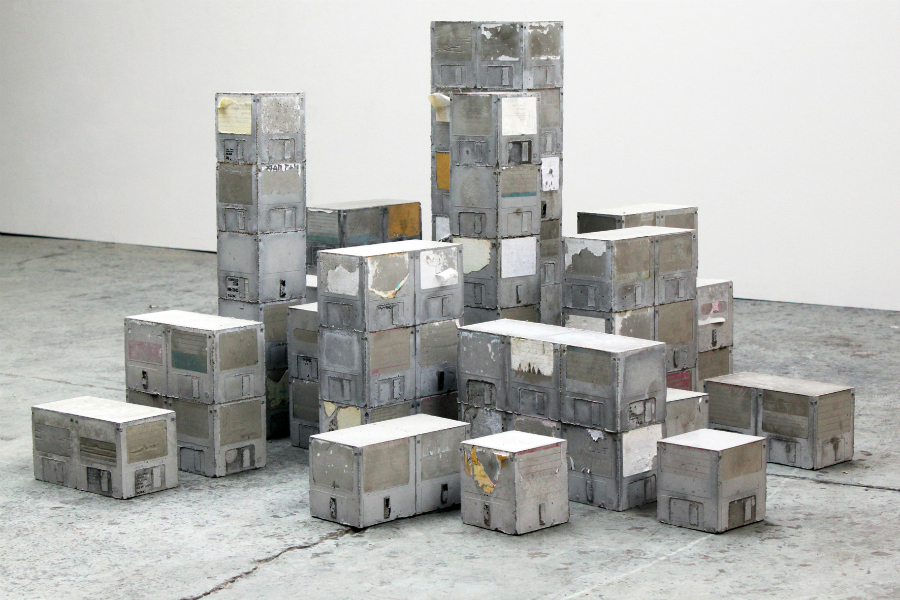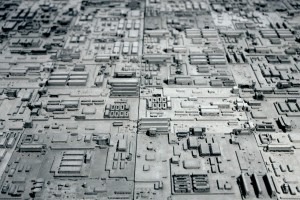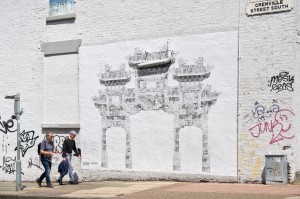An Archaeological Impulse: Robin Tarbet

Floppy disks, fossils and the fallibility of new technologies: Stephen Clarke explores the work of Robin Tarbet…
The ancient city of Pompeii lay dormant for nearly fifteen hundred years concealed under layers of lapilli and ash. Since the mid-eighteenth century, archaeologists have slowly reclaimed its topography, and the trace of its long-dead inhabitants has been retrieved through the process of plaster casts. To the visitor the grid of the city plan is apparent, but the purpose of each of Pompeii’s buildings needs decoding by the specialist.
It is this mystery of architectural structures that is alluded to in Robin Tarbet’s work. Through casts and prints made from the components of electronic technology, Tarbet visualises new cities.
Tarbet, born 1981, studied printmaking at Norwich School of Art and Design, and the Royal College of Art. Printmaking is a process-orientated discipline that has an emphasis upon surface and is created in multiples. As an artistic practice that is linked to an industry, it is sensitive to changes in technology; either positioning itself as defiantly traditional or keeping apace with the new processes. The heavy machinery of printing presses has made way for the lighter plastic updates.
As a consequence, the relationship between the artist and his tools has also changed. The physical craft of the artisan has been replaced by the adeptness of the user. The antagonism between redundant technologies and their replacements is enacted by Tarbet’s use of archaic technologies to make images of the newer electronic devices. By simple means, he produces fixed memorials to the redundant artefacts of continued progress.
The floppy disc is an example of the ‘new now old’. A ubiquitous tool for data storage in the 1980s and ‘90s, it became obsolete by the turn of the century. Tarbet has used this outmoded device to fabricate a printing plate; fixing a collection of floppy discs in rows on to a board with a glue gun, and inking their surface, he made the most basic of prints — a collagraph. The grid of printed box-shaped floppy discs refers to the mass-production of this object and the multiple nature of printmaking.
The data stored on these unwanted discs had become difficult to retrieve, and as with the ancient city of Pompeii, what remained was the container emptied of its meaning.

Tarbet has also used floppy discs to make concrete casts, in effect turning them into fossils. As reliefs presented on the wall or stacked as towers on the floor, these relics have a sculptural quality, and can be read as diminutive homages to the work of artist Rachel Whiteread. Tarbet has physically pulled apart the inner worlds of the ‘technocrat’, dismantling equipment such as televisions and computers to look behind the scenes.
Acutely aware of his own lack of understanding of how these machines operate, he extracts their mysterious components to construct his own non-functioning circuit boards. Using these as templates, he makes casts that enable him to fabricate concrete ‘tiles’ which can be brought together to produce a landscape; resembling the modern cityscape, or more specifically, its industrial sites. Scale is important, as the micro environment is mistaken for the macro. The inner workings of the electronic box are a clone of its parent factory complex.
By using concrete instead of ink to chart this topography, Tarbet has seemingly moved from printmaking to sculpture, but it is not volume that he draws attention to, rather it is surface that he examines. The raised surface of the concrete cast also relates to the relief printing plate.
In his Monitored Landscape installations, Tarbet attempts to get inside his creations. For these projects, a model train runs on tracks through large versions of his fabricated circuit board landscapes; a small camera mounted on top of the train films the journey. Watching this footage, the viewer travels around this representation of the industrial scene. In the same way that we travel around a city via digital technology, looking at the real reduced to its screen version, Tarbet’s electronic cities have actuality.
Within our modern cities we have little or no idea of the function of buildings; it takes the knowledge of the present day archaeologist to decipher their meaning. Tarbet’s landscapes suggest similar functionality, but their existence relies upon illusion. Digital photographs made from the train’s journey through this wonderland show blurred images that get no further than the façade of these miniature units. Gamma (1999) by Jane and Louise Wilson takes the viewer on a similar journey around an installation. A four-screen video projection that was shot at the former United States Air Force base on Greenham Common, Gamma takes the viewer around this now abandoned base that once housed the nation’s nuclear weapons. As with Tarbet’s Monitored Landscapes, the viewer is lost in a labyrinthine space that makes little sense. It takes expert knowledge to interpret the workings of a complex that would have played an important part in our possible annihilation.
The living city of Pompeii was obliterated by a sudden apocalypse, leaving behind only its footprint. Aerial views show box-like spaces, linear routes, and large circular constructs. A purposeful geometry that provokes wonder and invites speculation, it underlines the differences between what we can see and what we can know.
In February 2003 the U.S. Secretary of State Colin Powell presented the UN Security Council with ‘evidence’ that Iraq was building weapons of mass destruction. Satellite images, we were told, showed weapon installations, consequently justifying the invasion of Iraq and the reconfiguring of a landscape older than Pompeii. The testimony of the expert has since been brought into question. Misinterpretation can lead to devastation. With basic tools Robin Tarbet playfully raises questions about the fallibility of new technologies and our reliance on what is buried beneath the surface.
Stephen Clarke is an artist, writer, and lecturer based in the north-west
See Robin Tarbet’s work at the Bluecoat Liverpool until 13th April 2014 — curated by Fran Disley (Manager, Print at the Bluecoat). Tarbet will work at the Print Studios to create a print for the occasion of the exhibition; a collaborative model that will develop with forthcoming exhibiting artists.
Tarbet’s work accompanies The Negligent Eye, on show until 15 June 2014, free entry — curated by Jo Stockham, Professor of Printmaking at the Royal Collage of Art





